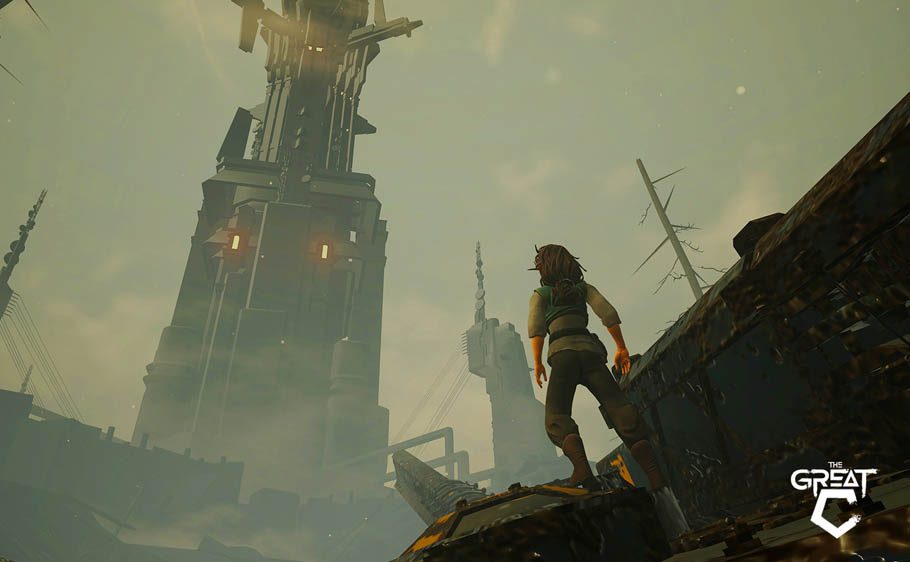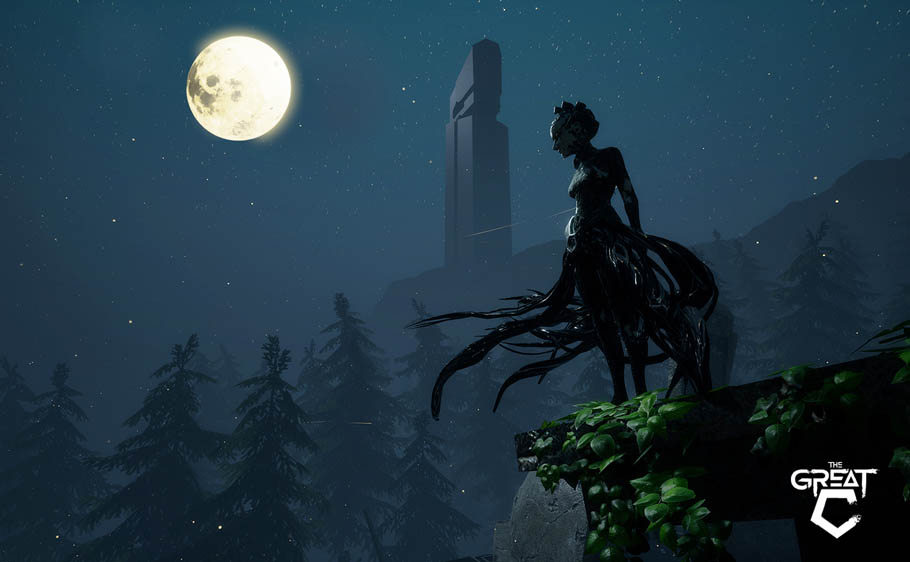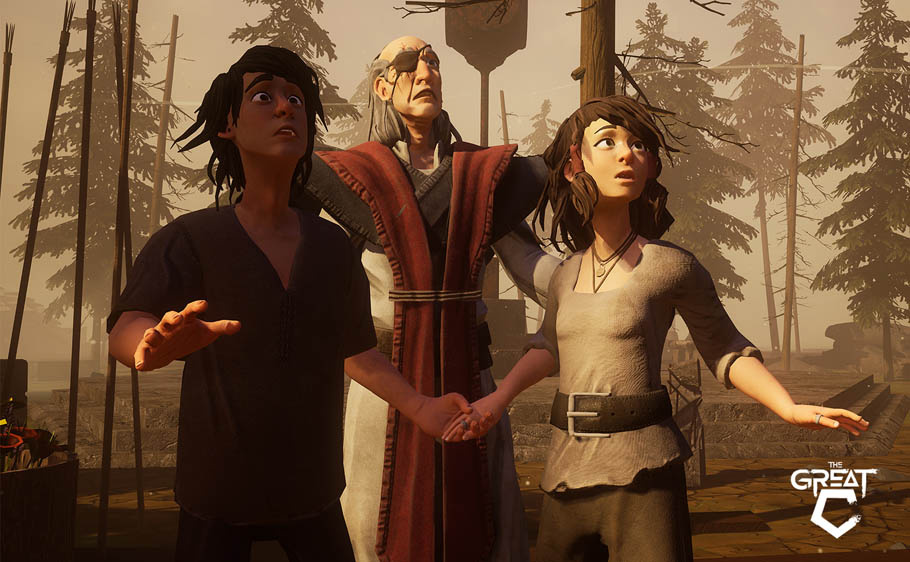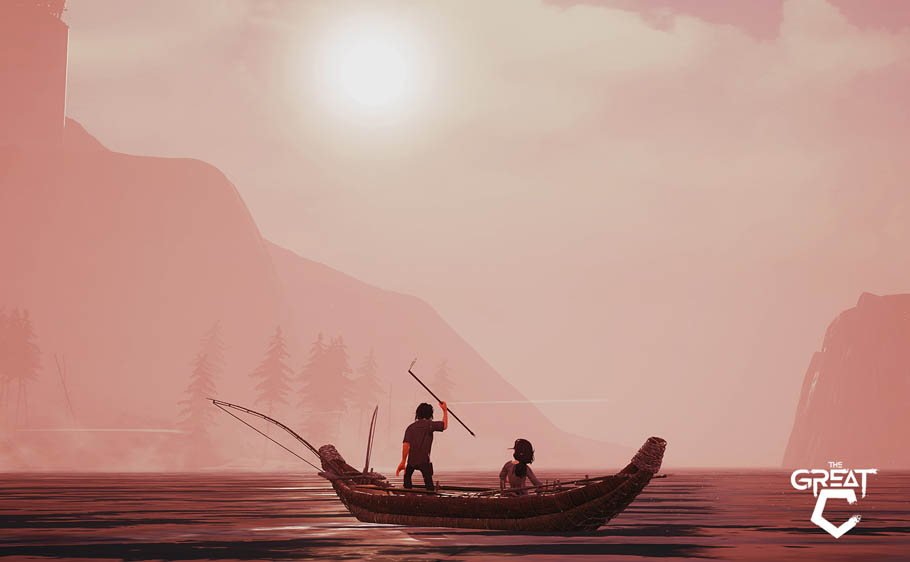Science fiction legend Philip K. Dick’s work has been adapted many times in many mediums, but none of his original material has appeared in VR form. Considering Dick practically invented the ‘reality is not real’ subgenre of SF, it’s surprising more of his works haven’t debuted in virtual worlds.
That might change with The Great C, developed by Secret Location, and releasing today on Viveport (also launching in Viveport Subscription).
We managed to track down several Secret Location team members to quiz them about the story behind The Great C and why Dick’s work seemed perfect for VR.
Who are Secret Location (if it’s not secret) and where are you based?
Luke Van Osch, Producer: Ha! We actually have two (not so secret) locations. We are based in Toronto, and also have a satellite office in Los Angeles. We were founded in 2009 and acquired by Entertainment One in 2016. We focus on both the creation and distribution of our own and partner VR content. On the content side, we launched the hit bullet hell shooter, Blasters of the Universe, with VR puzzle game Transpose also coming this year. And on the distribution side, the team is getting ready to launch some exciting new features for our VR distribution platform, Vusr, which is currently being used by a number of major publishers.
Tell us about The Great C.
Luke Van Osch, Producer: The Great C is set in a bleak future, where most of humanity was wiped out by a mysterious apocalyptic event called “The Smash.” The remnants of society live in humble tribes and are ruled by an all-powerful supercomputer known as the Great C. Each year, the village is forced to send a young person on a pilgrimage to appease the mysterious machine, a journey from which no one returns.
Dick’s original story follows one man on that pilgrimage. Our story features an original character called Clare. She’s a young woman whose fiancé is summoned for this year’s pilgrimage, and the story details the choices she makes to try to disrupt this vicious cycle.

The Great C was originally published in 1953, making it one of Philip K Dick’s earliest published works. What made you think it would work well in VR?
Luke Van Osch, Producer: There were a number of elements in the short story we liked. We were drawn to the post-apocalyptic setting, which we thought would be a really engaging environment for VR. The story of a youth getting sent off each year to certain doom was a compelling premise, and then there were the interesting themes and motifs; the David and Goliath scenario, Man versus Machine, and the concept of having a ‘duty’ to do something when there’s no chance of success – or even a totally clear idea of why you have to do it.
Surprisingly, your adaptation of The Great C is entirely story-led, rather than interactive. That’s an unusual choice for VR. What led you to that choice?
Luke Van Osch, Producer: As this is the first Philip K Dick property to be adapted into VR, we wanted to deliver a cutting-edge cinematic experience that would help push the medium of VR forward.
The original story of The Great C is fairly limited in scope, so we focused on creating a rich and substantial narrative for our VR version. The final result has a runtime of 37mins, a variety of characters, and spans over 20 different environments. That scope makes sure it’s a rewarding piece of standalone content.
Along with that, we made it a goal for our version of The Great C to ‘feel’ like a cinematic experience. We focused on adapting film language and techniques, like editing, composition, scene transitions, camera movement, and pacing for VR, to give the piece the tempo and excitement of a big screen movie.
A large part of achieving that goal was working with terrific collaborators, like noted film composer Junkie XL (Mad Max: Fury Road, Deadpool, Tomb Raider). The score is a big part of what brings the piece to life.

How does a story-led experience work in VR, practically?
Luke Van Osch, Producer: The Great C is a fully animated, fully volumetric, real-time experience. But it’s also a highly orchestrated, highly authored narrative, where we closely control the presentation of the story, manipulating time and space in the same sort of way as films. Like most films, The Great C is presented in the third person and we use camera cuts to tell the story, moving the viewer quickly through time and space.
In a practical sense, this means The Great C was designed as a passive seated experience, where the viewer is invited to take in the presentation of the story, as opposed to driving the story forward themselves. The viewer is certainly still free to look around the space, taking advantage of that amazing aspect of VR, but we put the emphasis on a higher tempo form of storytelling that focuses the viewer’s attention on following the tightly orchestrated scenes.
Did you always want to adapt The Great C in that way, or did it evolve during development?
Luke Van Osch, Producer: We actually started off developing the project with a lot more interactivity in mind. The very first version of The Great C was a lot more like a game, where you controlled a character the whole time.
After that, we played around with ideas of dividing the piece up into passive and interactive portions, but along the way we started gravitating towards making a more cinematic experience and kept finding that the handoff between the interactive and passive portions was getting in the way of that.
Eventually, we made the decision to go all in on the authored, cinematic approach.

What inherent advantages do you see in VR versus a 2D adaptation?
Steve Miller, Director: Different mediums, be it books, movies, TV shows or live theatre all offer unique opportunities for storytelling.
For us, VR’s strengths of immersion and intimacy between viewer and story were an exciting fit to adapt a narrative with such a fantastical setting and characters whose journey we really wanted the audience to feel a part of.
One of our biggest goals on this project was to find ways to adapt and translate cinematic storytelling principles into VR. We really wanted to push what is possible in terms of editing, shot composition and camera movement. Especially as VR audiences become more accustomed to the medium, we believe evolving these sorts of tools will pave the way for even more sophisticated VR storytelling.
Did you make any specific choices during development to ensure the story of The Great C worked well in VR?
Steve Miller, Director: We were always sensitive to creating an optimal viewing experience throughout the production. We did extensive user testing and refinement of our editing choices.
Initially, we played with allowing the user some control over camera switching, but ultimately concluded that the most rewarding experience was to architect the central action to always play out in the front 180º of a user’s field of view.
Of course we also appreciate that an inherent benefit of the VR medium is it’s replay-ability appeal for discovering all the little details about the world around you!

Tell us about the production of The Great C; how big was the team and how long did it take to put together?
Luke Van Osch, Producer: The production team would fluctuate in size, but on average there were around 12-14 people working on it full time. The production cycle started with a discovery phase that lasted a few months early on, and then a smaller team spent a month or so prepping the build for shipping and distribution. The core production phase lasted 9-10 months.
I have to give huge credit to the team, because I think they accomplished a ton of work in a short amount of time. The production cycle was very similar to the other VR projects we make, like our upcoming puzzle game Transpose. Secret Location just has a knack for getting a lot done in a short amount of time!
The Great C was your first Unreal Engine project. Was that a deliberate goal of the studio, or were there specific things Unreal could do you wanted to exploit?
Luke Van Osch, Producer: We’d always wanted to try making something in Unreal, and with The Great C being an artist heavy team, we thought the engine would be a good fit. We wanted to let the team use the mature and powerful visual and animation tools available there.
Congrats on being selected to the Venice Film Festival. Do you feel there’s more of a future for computer-generated projects, as opposed to 360 video, in film festivals?
Luke Van Osch, Producer: Venice was a great experience. It was really encouraging and rewarding to see how much emphasis they put on the VR section there, totally incorporating it as an equal part of the festival.
The Programmers for Venice VR do an incredible job at showcasing a wide variety of innovative content ranging in format and genre. It was amazing to see and get to experience that breadth of work in one place.
In these early days of the medium, I think everyone is still figuring out what’s possible, and it’s most important to just bring general awareness to VR and encourage the people that are making it. Eventually, the different sub-formats and genres will divide up and be compared on their own. I’m guessing that will sort of happen naturally, and will be a great sign that the industry has matured.
And finally: anything you can tell us about upcoming projects from Secret Location?
Kathryn Rawson, Head of Content: We are currently in pre-production on a free roam project and are excited to explore the untethered world of VR. We are also developing a slate of additional projects, also focused on the location based entertainment space.
Thanks to everyone at Secret Location for answering our questions!
The Great C is available now on Viveport, and as part of Viveport Subscription.
Website: LINK


